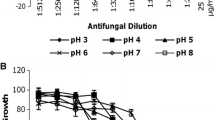Abstract
Candida albicans starved cells were incubated in minimal synthetic liquid media containing different concentrations of ammonium sulphate (0.00, 0.02, 0.05, 0.10, 0.03, 0.50 g/L). Culture growth was monitored by measuring daily the optical density and by evaluating RNA and protein cellular content after 48 and 96 hours from the inoculum. The environmental availability of ammonium ion influenced the biomass production, that was maximum when its concentration was 0.10 and 0.30 g/L. In addition, an effect on cell duplication time was observed, this was particularly evident when the (NH4)2SO4 concentration was 0.10 g/L. The protein content increased in relation to the increase of ammonium ion availability, with a peak in correspondence to 0.30 g/L and a drop when the greatest concentrations were employed. RNA production was inversely proportional in respect to protein production. The optimal range of ammonium sulphate concentration forC. albicans growth was 0.10–0.30 g/L; over these concentrations there was an inhibitory effect. The rate of the protein and RNA syntheses seems to indicate the growth phase and the nitrogen nutritional conditions of the cultures, respectively.
Similar content being viewed by others
References
Odds FC. Candida and candidosis, 2nd ed. London: Bailliere-Tindall, 1908.
Kreger-van Rij NJW. The yeast: A taxonomic study, 3rd edition revised and enlarged. Amsterdam: Elsevier Science Publishers, 1984.
Egbosimba EE, Slaughter JC. The influence of ammonium permease activity and carbon source on the uptake of ammonium from simple defined media bySaccharomyces cerevisiae. J. Gen Microbiol 1987; 133: 375–79.
Egli TH, Quayle JR. Influence of the carbon:nitrogen ratio of the growth medium on the cellular composition and the ability of the methylotrophic yeastHansenula polimorpha to utilize mixed source. J Gen Microbiol 1986; 132: 1779–88.
Franco CMM, Smith JE, Barry DR. Effect of nitrogen and phosphate levels of intermediates in baker's years growth in continuous culture. J. Gen Microbiol 1984; 130: 2465–72.
Kole MM, Thompson BG, Gerson DF. Ammonium concentration control in fed-batch fermentations ofSaccharomyces cerevisiae. J. Ferment Technol 1985; 63: 211–14.
Peña A, Pardo JP, Ramirez J. Early metabolic effects and mechanism of ammonium transport in yeast. Arch Biochem Biophys 1987; 253: 431–38.
Pinon R. Effects of ammonium ions on sporulation ofSaccharomyces cerevisiae. Exp Call Res 1977; 105: 367–78.
Lloyd D., Bodil K, Deng H. Glycolisis and respiration in yeasts: the effect of ammonium ion studied by mass spectrometry. J. Gen Microbiol 1983; 129: 2125–27.
Park D. Inorganic nitrogen nutrition and yeast mycelial dimorphism inAureobasidium pullulans. Trans Br Mycol Soc 1982; 78: 385–88.
Park D. Amino acid nutrition and yeast-mycelial dimorphism inAuereobasidium pullulans. Trans Br Mycos Soc 1982; 79: 170–72.
Seville MJ, Isusi P, Gutierrez, R, Egea L, Uruburu F. Influence of carbon and nitrogen source on the morphology ofPullularie pulluians. Trans Br Mycol Soc 1977; 68: 300–303.
Dabrowa N, Howard DH, Landau JW, Schechter Y. Synthesis of nucleic acid and protein in the dimorphic form ofCandida albicans. Sabouraudia 1970; 8: 163–69.
Dabrows N, Taxer SS, Howard DH. Germination ofCandida albicans induced by proline. Infect Immun 1976; 13: 830–35.
Lee KL, Buckley HR, Campbell CC. An amino acid liquid synthetic medium for the development of mycelial and yeast form ofCandida albicans. Sabouraudia 1975; 13: 148–53.
Pollack JH, Hashimote T. Ethanol-induced germ-tube formation inCandida albicans. J. Gen Microbiol 1985; 131: 3303–10.
Shepherd MG, Chiew YY, Ram SP, Sullivan PA. Germtube induction inCandida albicans. Can J Microbiol 1980; 26: 21–26.
Vidotto V, Guevara Ochoa L, Cortes JM, Bruatto M. Optimal concentration of ammonium ion in a minimal synthetic medium for the growth ofCandida albicans. Mycopathologia 1990; 113: 139–142.
Vidotto V. Pugliese A, Gioannini P. Growth ofCandida albicans in a minimal synthetic medium without biotin. Mycopathologial 1987; 100: 7–15.
Herbert DPJ, Phipps R, Strange RE. Chemical analysis of microbial cell. In: Norris JR, Ribbons DW, eds. Methods in microbiology, Vol. 5B. New York: Academic Press, 1971.
Bradford MA. Rapid and sensitive method for the quantitation of microgram quantities of protein utilizing the principle of protein-dye binding. Anal Biochem 1976; 72: 248.
Bruatto M, Olivero MT, Perotti D, Maina AM, Bugnone C, Benech S. Comportamento diCandida albicans in un periodo di carenza nutrizionale: Risultati preliminari. Giorn Batt Virol Immun 1989; 57: 115–20.
Author information
Authors and Affiliations
Rights and permissions
About this article
Cite this article
Vidotto, V., Benech, S., Maina, A.M. et al. Influence of different levels of ammonium concentrations on cell growth, RNA and protein production byCandida albicans . Mycopathologia 123, 19–25 (1993). https://doi.org/10.1007/BF01103484
Received:
Accepted:
Issue Date:
DOI: https://doi.org/10.1007/BF01103484




